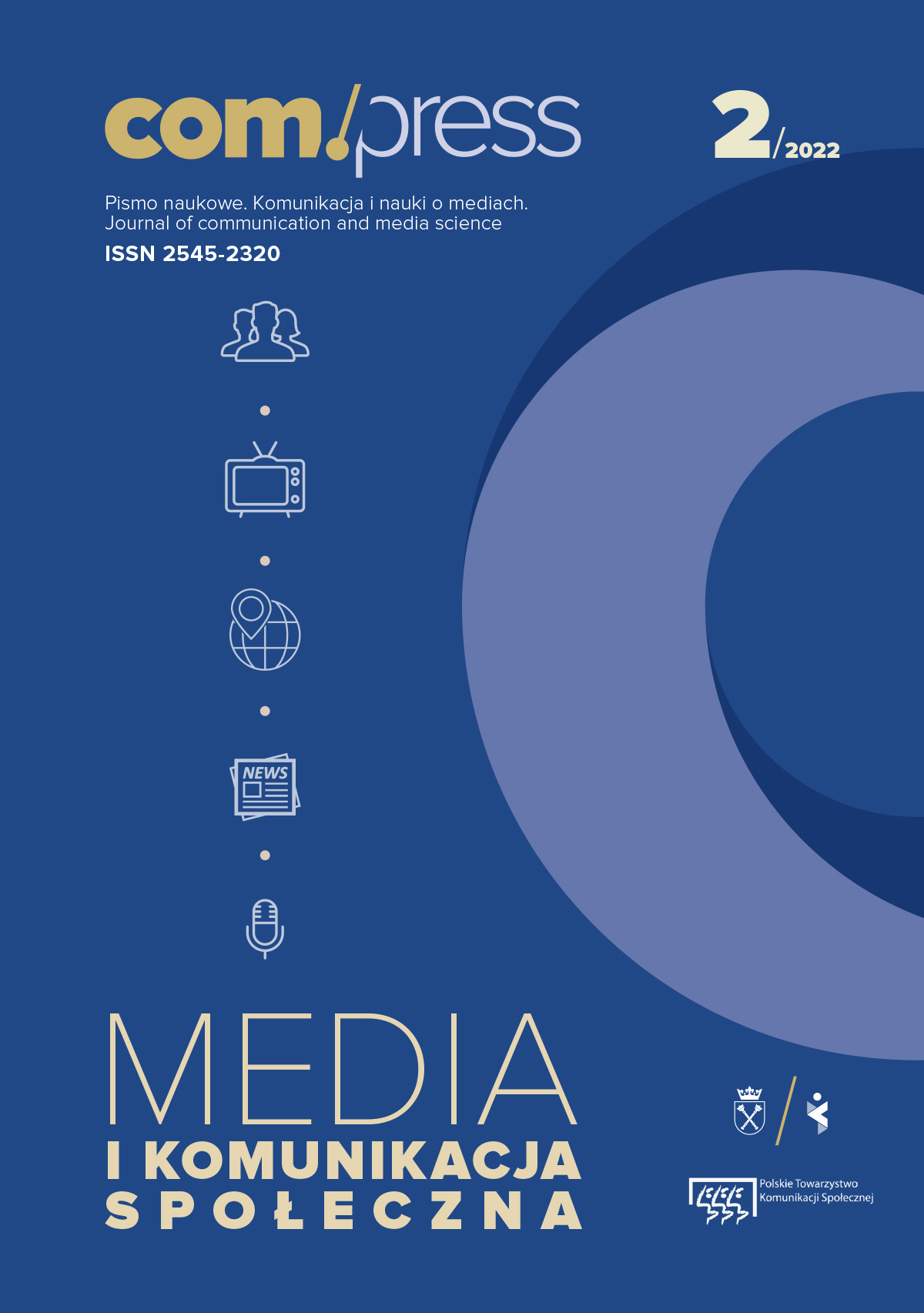Wyzwania i korzyści płynące z teleterapii i wykorzystania świata cyfrowego w praktyce arteterapeutycznej. Przegląd integracyjny
DOI:
https://doi.org/10.51480/compress.2022.5-2.472Słowa kluczowe:
arteterapia, technologia cyfrowa, cyfrowe media artystyczne, terapia online, przegląd integracyjnyAbstrakt
Biorąc pod uwagę, że współczesne technologie umożliwiają prowadzenie psychoterapii na odległość, ważna dla jej praktyków staje się dyskusja na temat wad i zalet wykorzystania do tego celu cyberprzestrzeni. Celem niniejszego artykułu jest przedstawienie negatywnych i pozytywnych cech arteterapii w formie online. Tekst bazuje na integracyjnym przeglądzie recenzowanej literatury na temat wykorzystania technologii cyfrowych w psychoterapii i terapii sztuką. Uwzględniono nie tylko badania, które przedstawiały wyniki empiryczne, ale także badania obserwacyjne i jakościowe, w których oceniano skuteczność e-terapii i arteterapii online. Wyniki badań wskazują na wysoką akceptację klientów i terapeutów oraz pozytywne aspekty związane z tą metodą prowadzenia psychoterapii, takie jak przyjemność katartyczna i multimodalne środowisko ekspresji. Niemniej jednak, terapeuci sztuki chcący prowadzić psychoterapię w trybie online napotykają na szereg wyzwań, w tym brak walorów dotykowych oraz trudności w zarządzaniu i radzeniu sobie z sytuacjami kryzysowymi na odległość. Mimo, że cyberprzestrzeń zapewnia wolność ekspresji dla klientów i usług terapii sztuką na całym świecie, potrzeba biegłości technologicznej ogranicza dostęp do terapii. Dodatkowo, istnieją obawy etyczne, polegające na zmniejszonym zaufaniu w relacji terapeutycznej i utracie kontroli nad prowadzeniem sesji psychoterapii kryzysowej w formie online.
Bibliografia
Alders, A., Beck, L., Allen, P., & “Basia” Mosinski, B. (2011, 12 21). Technology in Art Therapy: Ethical Challenges. Journal of the American Art Therapy Association, 28(4), 165–170. Retrieved from http://dx.doi.org/10.1080/07421656.2011.622683
Brenes, G., Ingram, C., & Danhauer, S. (2011). Benefits and challenges of conducting psychotherapy by telephone. Professional Psychology: Research and Practice, 42(6), 543–549. doi:10.1037/a0026135
Carlton, N. (2014, 02). Digital culture and art therapy. The Arts in Psychotherapy, 41(1), 41–45. Retrieved from https://doi.org/10.1016/j.aip.2013.11.006
Castelnuovo, G., Buselli, C., Ferrari, R., Gaggioli, A., Mantovani, F., Molinari, E., . . . Riva, G. (2004). New tools in cybertherapy: the VEPSY Web Site. Studies in Health Technology and Informatics, 99, 15–35. doi:10.3233/978–1-60750–943–1-15
Choe, S. (2014). An exploration of the qualities and features of art apps for art therapy. The Arts in Psychotherapy, 41(2), 145–154. Retrieved from https://doi.org/10.1016/j.aip.2014.01.002
Collie, K., & Čubranić, D. (1999). An Art Therapy Solution to a Telehealth Problem. Journal of the American Art Therapy Association, 16(4), 186–193. Retrieved from https://doi.org/10.1080/07421656.1999.10129481
Collie, K., Bottorff, J., Long, B., & Conati, C. (2006, 02 26). Distance art groups for women with breast cancer: guidelines and recommendations. Support Care Cancer, 14, 849–858. doi:10.1007/s00520–005–0012–7
Collie, K., Hankinson, S. P., Norton, M., Dunlop, C., Mooney, M., Miller, G., & Giese-Davis, J. (2016, 02 24). Online art therapy groups for young adults with cancer. An International Journal for Research, Policy and Practice, 9(1), 1–13. Retrieved from https://doi.org/10.1080/17533015.2015.1121882
Ethical principles for art therapists. (2011). Retrieved from American Art Therapy Association: http://www.americanarttherapyassociation.org/upload/ethicalprinciples.pdf
Glueckauf, R., Pickett, T., Ketterson, T., Loomis, J., & Rozensky, R. (2003). Preparation for the delivery of telehealth services: A self-study framework for expansion of practice. Professional Psychology: Research and Practice, 34(2), 159–163. Retrieved from https://doi.org/10.1037/0735–7028.34.2.159
Haywood, S., & Grant, B. (2022, 07 05). Reimagining art therapy for the digitally-mediated world: a Hexagonal Relationship. International Journal of Art Therapy, 1–8. Retrieved from https://doi.org/10.1080/17454832.2022.2084124
Kaimal, G., Carroll-Haskins, K., Berberian, M., Dougherty, A., Carlton, N., & Ramakrishnan, A. (2020). Virtual Reality in Art Therapy: A Pilot Qualitative Study of the Novel Medium and Implications for Practice. Journal of the American Art Therapy Association, 37(1). Retrieved from https://doi.org/10.1080/07421656.2019.1659662
Kapitan, L. (2011, 04 22). Introduction to the Special Issue on Art Therapy’s Response to Techno-Digital Culture. Journal of the American Art Therapy Association, 26, 50–51. Retrieved from https://doi.org/10.1080/07421656.2009.10129737
Levya, C., Spoonerc, H., Leec, J., Sonked, J., Myerse, K., & Snowc, E. (2018, 02). Telehealth-based creative arts therapy: Transforming mental health and rehabilitation care for rural veterans. The Arts in Psychotherapy, 57, 20–26. Retrieved from https://doi.org/10.1016/J.AIP.2017.08.010
Luxton, D., Pruitt, L., & Osenbach, J. (2014). Best practices for remote psychological assessment via telehealth technologies. Professional Psychology: Research and Practice, 45(1), 27–35. Retrieved from https://doi.org/10.1037/a0034547
McNiff, S. (1999). The Virtual Art Therapy Studio. Journal of the American Art Therapy Association, 16(4), 197–200. Retrieved from https://doi.org/10.1080/07421656.1999.10129484
Orr, P. (2012, 04 12). Technology use in art therapy practice: 2004 and 2011 comparison. 39(4), 234–238. Retrieved from https://doi.org/10.1016/j.aip.2012.03.010
Schaper, E. (1968). Aristotle’s Catharsis and Aesthetic Pleasure. The Philosophical Quarterly, 18, 131–143. Retrieved from https://www.jstor.org/stable/2217511
Schaverien, J. (2011). The triangular relationship and the aesthetic countertransference in analytical art psychotherapy. In M. Gerry, The changing shape of art therapy : new developments in theory and practice (pp. 55–83). London: Jessica Kingsley Publishers.
Snyder, K. (2021, 02 01). The digital art therapy frame: creating a ‘magic circle’ in teletherapy. International Journal of Art Therapy, 104–110. Retrieved from https://doi.org/10.1080/17454832.2020.1871389
Spooner, H., Lee, J., Langston, D., Sonke, J., Myers, K., & Levy, C. (2019). Using distance technology to deliver the creative arts therapies to veterans: Case studies in art, dance/movement and music therapy. The Arts in Psychotherapy, 62, 12–18. Retrieved from https://doi.org/10.1016/j.aip.2018.11.012
Stamm, H. (1988). Clinical applications of telehealth in mental health care. Professional Psychology: Research and Practice, 29(6), 536–542. Retrieved from https://doi.org/10.1037/0735–7028.29.6.536
Zubala, A., & Hackett, S. (2020, 12 15). Online art therapy practice and client safety: a UK-wide survey in times of COVID-19. International Journal of Art Therapy, 25(4), 161–171. Retrieved from https://www.tandfonline.com/doi/full/10.1080/17454832.2020.1845221
Zubala, A., Kennell, N., & Hackett, S. (2021, 04 08). Art Therapy in the Digital World: An Integrative Review of Current Practice and Future Directions. Frontiers in Psychology. Retrieved from https://doi.org/10.3389/fpsyg.2021.600070
Downloads
Opublikowane
Jak cytować
Numer
Dział
Licencja
Copyright (c) 2022 Polskie Towarzystwo Komunikacji Społecznej

Utwór dostępny jest na licencji Creative Commons Uznanie autorstwa – Na tych samych warunkach 4.0 Miedzynarodowe.
Treść artykułów jest objęta licencją na podstawie międzynarodowej licencji Creative Commons Attribution 4.0





